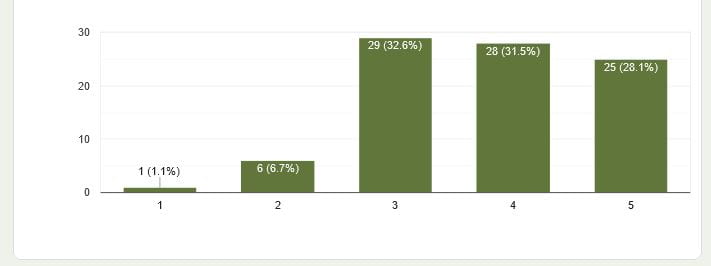I’ve been having my students complete a weekly bilingual check-in every Monday since school began.
I’ve blogged about it before – it’s been invaluable and I plan on doing it next year, too. I’ve gained important information that has helped me adjust my instruction and provide social emotional support to students.
I thought it would be useful to review the check-ins from the past ten months and see if I could identify any trends.
I’ve taken check-in results from September 14th, November 30th, January 25th, March 8th, and May 24th, and will screenshot – in that order – results from the different questions (I’ve added or removed some questions during the year, so not all surveys have the same ones):
QUESTION ONE:
NOTE: This question wasn’t added until the January Check-In – until that time I did separate Google Forms specifically on our classes.
Analysis: It looks there has been a very tiny drop in students’ feeling about our classes but, overall, it seems like it has stayed relatively positive. Student evaluations over the past seventeen years have generally been more positive than this but, considering that up until last month we were doing full-time remote teaching, I feel okay about the results. I have worked harder than any other years during my teaching career, and I really can’t think of anything more I could have done.
QUESTION TWO:
Analysis: It began relatively low in September as I think we teachers and our school’s administrators were trying to figure out the ins-and-outs of remote teaching, but it clearly began to move up, with a slight downtick this month. I think this upward swing is a testament to how hard everyone has been working to be present to our students.
Question Three:
NOTE: There was a technical snafu with the March results for this question.
Analysis: There seems to be have been an uptick in how students were feeling about their personal lives as the year went on. Our school neighborhood was one of the hardest-hit by COVID 19 in the Sacramento region, so it makes sense that students felt better as the pandemic lessened due to vaccinations.
Question Four:

NOTE: There was a technical snafu with the March results for this question.
Analysis: Obviously, there were a number of issues at the beginning of the year. Thanks to the work of teachers and administrators, particularly Assistant Principal Rick Godnick, most tech issues were taken care of relatively quickly.
Questions Five & Six:
NOTE: I didn’t start asking these questions until December. I’m not going to share the hundreds of different goals students set for themselves (finishing particular work, increasing grades in specific classes, etc.), but I will share what they said about if they accomplished them or not:
Analysis: These are self-reported results, of course, but there does seem to be a small, but steady, increase in the number of students saying they achieved their goals. There’s no way of telling how useful these two questions really were, but I think it was successful if it just got a few students thinking about goals and doing some reflection on them.
Question Seven:
NOTE: We just began in-person classes (concurrent/hybrid teaching) last month, so I don’t have responses from earlier in the year. Here’s the latest result:
Analysis: I’m doing my best, and concurrent teaching is hard. I’ll take these results. The survey also follows-up with a question asking:
Can you share any suggestions on how Mr. Ferlazzo can make his classroom a better place for you? SOLO CONTESTE ESTA PREGUNTA SI ESTÁ ASISTIENDO A LA ESCUELA EN PERSONA: ¿Puede compartir alguna sugerencia sobre cómo el Sr. Ferlazzo puede hacer que su salón de clases sea un lugar mejor para usted?
All the responses I’ve received have been variations of “No, you’re doing a great job.”
Question Eight:
I’m not going to share responses here, but I have previously posted about how valuable this question, and its responses, have been.
Last month, I also published results of more detailed anonymous student evaluations of my classes. You might be interested in them:
HOW MY ELL HISTORY STUDENTS HAVE EVALUATED OUR CLASS – AND ME!
HOW MY THEORY OF KNOWLEDGE STUDENTS EVALUATED OUR CLASS – AND ME!
Let me know if you have any other thoughts on how to analyze these results and what I can learn from them.































Recent Comments